
Mankiw Macroeconomics (5th ed)
.pdf
C H A P T E R 1 3 Aggregate Supply | 369
C A S E S T U D Y
The Sacrifice Ratio in Practice
The Phillips curve with adaptive expectations implies that reducing inflation requires a period of high unemployment and low output. By contrast, the rationalexpectations approach suggests that reducing inflation can be much less costly. What happens during actual disinflations?
Consider the U.S. disinflation in the early 1980s.This decade began with some of the highest rates of inflation in U.S. history.Yet because of the tight monetary policies the Fed pursued under Chairman Paul Volcker, the rate of inflation fell substantially in the first few years of the decade.This episode provides a natural experiment with which to estimate how much output is lost during the process of disinflation.
The first question is, how much did inflation fall? As measured by the GDP deflator, inflation reached a peak of 9.7 percent in 1981. It is natural to end the episode in 1985 because oil prices plunged in 1986—a large, beneficial supply shock unrelated to Fed policy. In 1985, inflation was 3.0 percent, so we can estimate that the Fed engineered a reduction in inflation of 6.7 percentage points over four years.
The second question is, how much output was lost during this period? Table 13-1 shows the unemployment rate from 1982 to 1985. Assuming that the natural rate of unemployment was 6 percent, we can compute the amount of cyclical unemployment in each year. In total over this period, there were 9.5 percentage points of cyclical unemployment. Okun’s law says that 1 percentage point of unemployment translates into 2 percentage points of GDP. Therefore, 19.0 percentage points of annual GDP were lost during the disinflation.
t a b l e 1 3 - 1
Unemployment During the Volcker Disinflation
|
|
Unemployment |
Natural |
Cyclical |
|||
|
Year |
Rate, u |
Rate, un |
Unemployment, u − un |
|
||
1982 |
9.5% |
6.0% |
3.5% |
|
|
||
1983 |
9.5 |
6.0 |
3.5 |
|
|
||
1984 |
7.4 |
6.0 |
1.4 |
|
|
||
1985 |
7.1 |
6.0 |
|
1.1 |
|
|
|
|
|
|
|
Total 9.5% |
|||
|
|
|
|
|
|
|
|
|
|
|
|
|
|
|
|
Now we can compute the sacrifice ratio for this episode.We know that 19.0 percentage points of GDP were lost and that inflation fell by 6.7 percentage points. Hence, 19.0/6.7, or 2.8, percentage points of GDP were lost for each percentage-point reduction in inflation.The estimate of the sacrifice ratio from the Volcker disinflation is 2.8.
User JOEWA:Job EFF01429:6264_ch13:Pg 369:27776#/eps at 100% *27776* |
Mon, Feb 18, 2002 12:57 AM |
|||
|
|
|
|
|
|
|
|
|
|
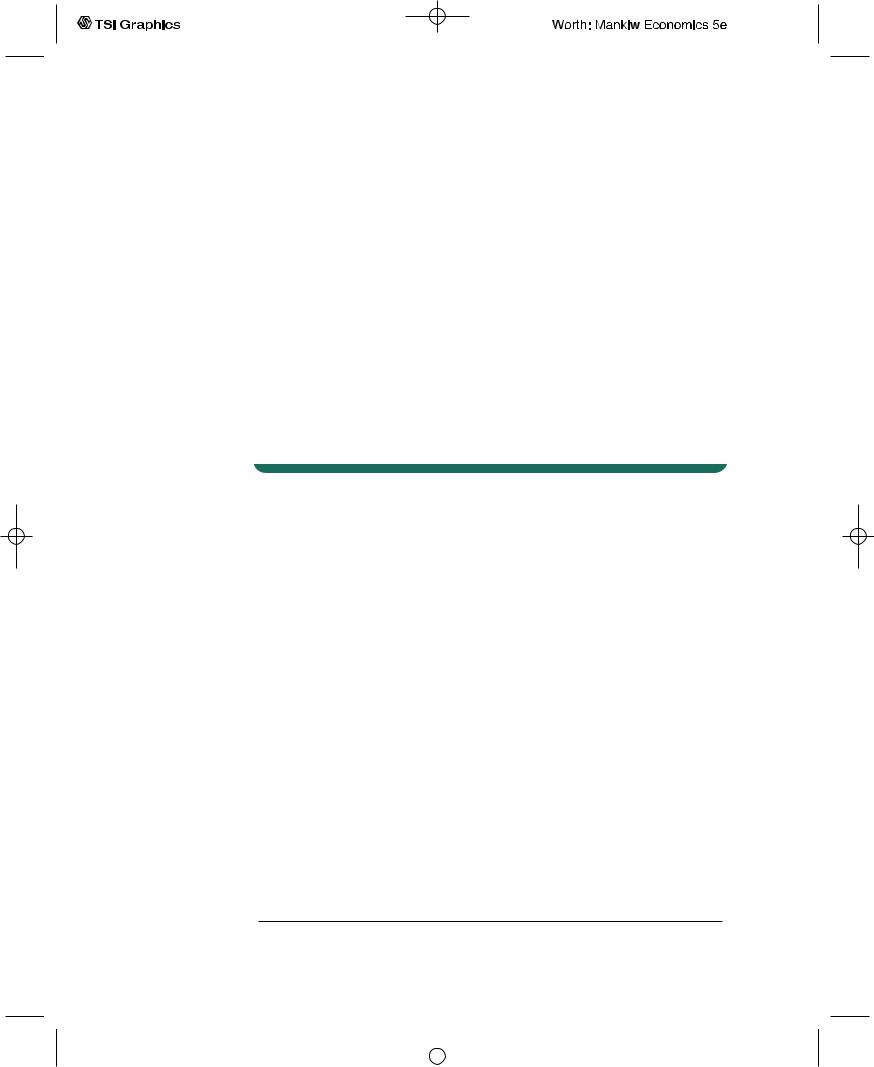
370 | P A R T I V Business Cycle Theory: The Economy in the Short Run
This estimate of the sacrifice ratio is smaller than the estimates made before Volcker was appointed Fed chairman. In other words,Volcker reduced inflation at a smaller cost than many economists had predicted. One explanation is that Volcker’s tough stand was credible enough to influence expectations of inflation directly.Yet the change in expectations was not large enough to make the disinflation painless: in 1982 unemployment reached its highest level since the Great Depression.
Although the Volcker disinflation is only one historical episode, this kind of analysis can be applied to other disinflations. A recent study documented the results of 65 disinflations in 19 countries. In almost all cases, the reduction in inflation came at the cost of temporarily lower output.Yet the size of the output loss varied from episode to episode. Rapid disinflations usually had smaller sacrifice ratios than slower ones.That is, in contrast to what the Phillips curve with adaptive expectations suggests, a cold-turkey approach appears less costly than a gradual one. Moreover, countries with more flexible wage-setting institutions, such as shorter labor contracts, had smaller sacrifice ratios. These findings indicate that reducing inflation always has some cost, but that policies and institutions can affect its magnitude.13
Hysteresis and the Challenge to the Natural-Rate
Hypothesis
Our discussion of the cost of disinflation—and indeed our entire discussion of economic fluctuations in the past four chapters—has been based on an assumption called the natural-rate hypothesis. This hypothesis is summarized in the following statement:
Fluctuations in aggregate demand affect output and employment only in the short run. In the long run, the economy returns to the levels of output, employment, and unemployment described by the classical model.
The natural-rate hypothesis allows macroeconomists to study separately shortrun and long-run developments in the economy. It is one expression of the classical dichotomy.
Recently, some economists have challenged the natural-rate hypothesis by suggesting that aggregate demand may affect output and employment even in the long run.They have pointed out a number of mechanisms through which recessions might leave permanent scars on the economy by altering the natural rate of unemployment. Hysteresis is the term used to describe the long-lasting influence of history on the natural rate.
A recession can have permanent effects if it changes the people who become unemployed. For instance, workers might lose valuable job skills when unemployed, lowering their ability to find a job even after the recession ends.
13 Laurence Ball, “What Determines the Sacrifice Ratio?” in N. Gregory Mankiw, ed., Monetary Policy (Chicago: University of Chicago Press, 1994).
User JOEWA:Job EFF01429:6264_ch13:Pg 370:27777#/eps at 100% *27777* |
Mon, Feb 18, 2002 12:57 AM |
|||
|
|
|
|
|
|
|
|
|
|

C H A P T E R 1 3 Aggregate Supply | 371
Alternatively, a long period of unemployment may change an individual’s attitude toward work and reduce his desire to find employment. In either case, the recession permanently inhibits the process of job search and raises the amount of frictional unemployment.
Another way in which a recession can permanently affect the economy is by changing the process that determines wages. Those who become unemployed may lose their influence on the wage-setting process. Unemployed workers may lose their status as union members, for example. More generally, some of the insiders in the wage-setting process become outsiders. If the smaller group of insiders cares more about high real wages and less about high employment, then the recession may permanently push real wages further above the equilibrium level and raise the amount of structural unemployment.
Hysteresis remains a controversial theory. Some economists believe the theory helps explain persistently high unemployment in Europe, because the rise in European unemployment starting in the early 1980s coincided with disinflation but continued after inflation stabilized. Moreover, the increase in unemployment tended to be larger for those countries that experienced the greatest reductions in inflations, such as Ireland, Italy, and Spain. Yet there is still no consensus whether the hysteresis phenomenon is significant, or why it might be more pronounced in some countries than in others. (Other explanations of high European unemployment, discussed in Chapter 6, give little role to the disinflation.) If it is true, however, the theory is important, because hysteresis greatly increases the cost of recessions. Put another way, hysteresis raises the sacrifice ratio, because output is lost even after the period of disinflation is over.14
13-3 Conclusion
We began this chapter by discussing three models of aggregate supply, each of which focuses on a different reason why the short-run aggregate supply curve is upward sloping. The three models have similar predictions for the aggregate economy, and all of them yield a short-run tradeoff between inflation and unemployment. A convenient way to express and analyze that tradeoff is with the Phillips curve equation, according to which inflation depends on expected inflation, cyclical unemployment, and supply shocks.
Keep in mind that not all economists endorse all the ideas discussed here. There is widespread disagreement, for instance, about the practical importance of rational expectations and the relevance of hysteresis. If you find it difficult to fit all the pieces together, you are not alone.The study of aggregate supply remains one of the most unsettled—and therefore one of the most exciting—research areas in macroeconomics.
14 Olivier J. Blanchard and Lawrence H. Summers,“Beyond the Natural Rate Hypothesis,’’ American Economic Review 78 (May 1988): 182–187; Laurence Ball, “Disinflation and the NAIRU,” in Christina D. Romer and David H. Romer, eds., Reducing Inflation: Motivation and Strategy (Chicago: University of Chicago Press, 1997): 167–185.
User JOEWA:Job EFF01429:6264_ch13:Pg 371:27778#/eps at 100% *27778* |
Mon, Feb 18, 2002 12:57 AM |
|||
|
|
|
|
|
|
|
|
|
|
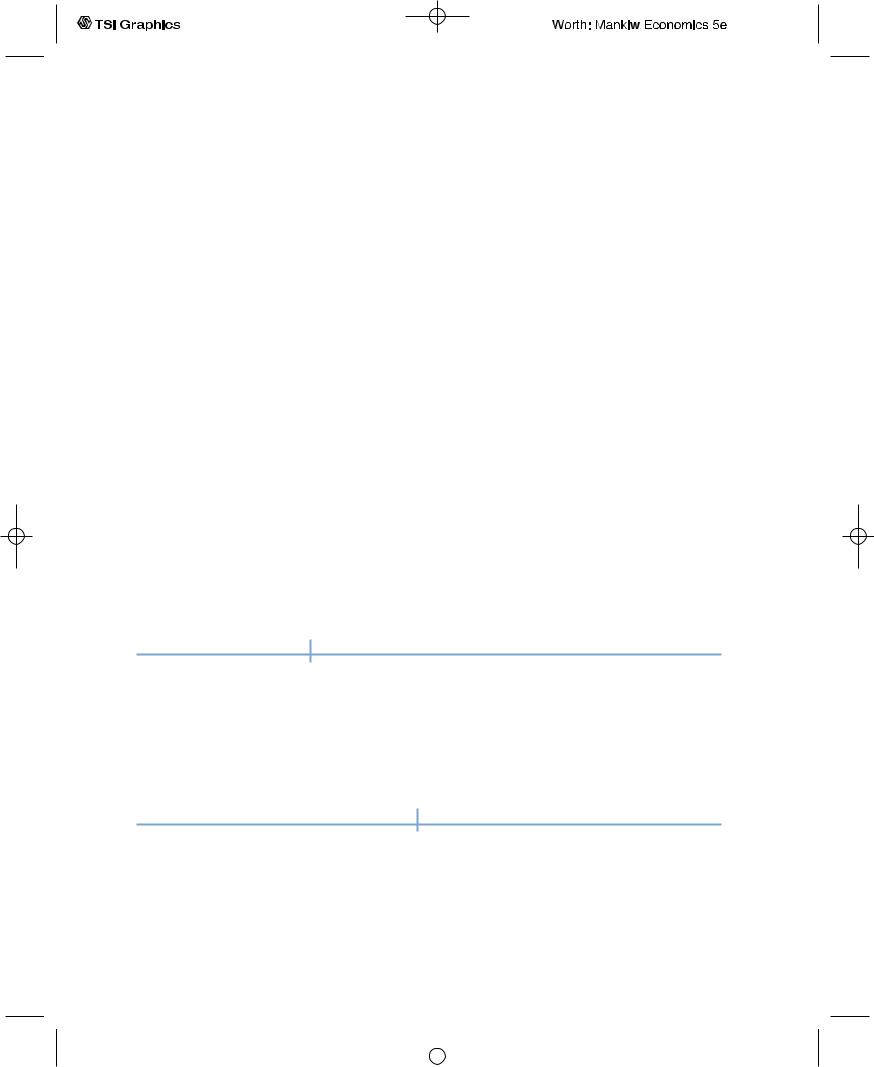
372 | P A R T I V Business Cycle Theory: The Economy in the Short Run
Summary
1.The three theories of aggregate supply—the sticky-wage, imperfect-informa- tion, and sticky-price models—attribute deviations of output and employment from the natural rate to various market imperfections. According to all three theories, output rises above the natural rate when the price level exceeds the expected price level, and output falls below the natural rate when the price level is less than the expected price level.
2.Economists often express aggregate supply in a relationship called the Phillips curve.The Phillips curve says that inflation depends on expected inflation, the deviation of unemployment from its natural rate, and supply shocks. According to the Phillips curve, policymakers who control aggregate demand face a short-run tradeoff between inflation and unemployment.
3.If expected inflation depends on recently observed inflation, then inflation has inertia, which means that reducing inflation requires either a beneficial supply shock or a period of high unemployment and reduced output. If people have rational expectations, however, then a credible announcement of a change in policy might be able to influence expectations directly and, therefore, reduce inflation without causing a recession.
4.Most economists accept the natural-rate hypothesis, according to which fluctuations in aggregate demand have only short-run effects on output and unemployment.Yet some economists have suggested ways in which recessions can leave permanent scars on the economy by raising the natural rate of unemployment.
K E Y C O N C E P T S
Sticky-wage model |
Adaptive expectations |
Rational expectations |
Imperfect-information model |
Demand-pull inflation |
Natural-rate hypothesis |
Sticky-price model |
Cost-push inflation |
Hysteresis |
Phillips curve |
Sacrifice ratio |
|
Q U E S T I O N S F O R R E V I E W
1.Explain the three theories of aggregate supply. On what market imperfection does each theory rely? What do the theories have in common?
2.How is the Phillips curve related to aggregate supply?
3.Why might inflation be inertial?
4.Explain the differences between demand-pull inflation and cost-push inflation.
5.Under what circumstances might it be possible to reduce inflation without causing a recession?
6.Explain two ways in which a recession might raise the natural rate of unemployment.
User JOEWA:Job EFF01429:6264_ch13:Pg 372:27779#/eps at 100% *27779* |
Mon, Feb 18, 2002 12:57 AM |
|||
|
|
|
|
|
|
|
|
|
|
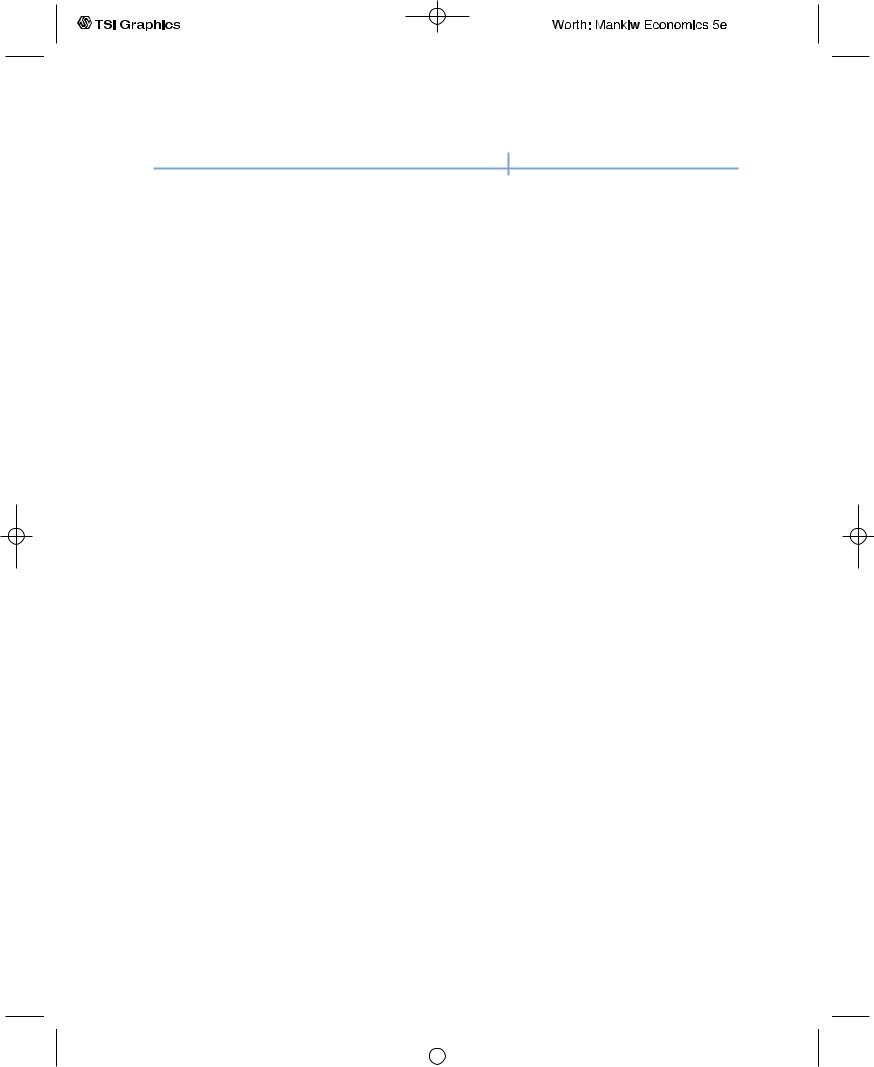
C H A P T E R 1 3 Aggregate Supply | 373
P R O B L E M S A N D A P P L I C A T I O N S
1.Consider the following changes in the stickywage model.
a.Suppose that labor contracts specify that the nominal wage be fully indexed for inflation. That is, the nominal wage is to be adjusted to fully compensate for changes in the consumer price index. How does full indexation alter the aggregate supply curve in this model?
b.Suppose now that indexation is only partial. That is, for every increase in the CPI, the nominal wage rises, but by a smaller percentage. How does partial indexation alter the aggregate supply curve in this model?
2.In the sticky-price model, describe the aggregate supply curve in the following special cases. How do these cases compare to the short-run aggregate supply curve we discussed in Chapter 9?
a.No firms have flexible prices (s = 1).
b.The desired price does not depend on aggregate output (a = 0).
3.Suppose that an economy has the Phillips curve
p = p−1 − 0.5(u − 0.06).
a.What is the natural rate of unemployment?
b.Graph the short-run and long-run relationships between inflation and unemployment.
c.How much cyclical unemployment is necessary to reduce inflation by 5 percentage points? Using Okun’s law, compute the sacrifice ratio.
d.Inflation is running at 10 percent. The Fed wants to reduce it to 5 percent. Give two scenarios that will achieve that goal.
4.According to the rational-expectations approach, if everyone believes that policymakers are committed to reducing inflation, the cost of reducing inflation—the sacrifice ratio—will be lower than if the public is skeptical about the policymakers’ intentions. Why might this be true? How might credibility be achieved?
5.Assume that people have rational expectations and that the economy is described by the stickywage or sticky-price model. Explain why each of the following propositions is true:
a.Only unanticipated changes in the money supply affect real GDP. Changes in the money supply that were anticipated when wages and prices were set do not have any real effects.
b.If the Fed chooses the money supply at the same time as people are setting wages and prices, so that everyone has the same information about the state of the economy, then monetary policy cannot be used systematically to stabilize output. Hence, a policy of keeping the money supply constant will have the same real effects as a policy of adjusting the money supply in response to the state of the economy. (This is called the policy irrelevance proposition.)
c.If the Fed sets the money supply well after people have set wages and prices, so the Fed has collected more information about the state of the economy, then monetary policy can be used systematically to stabilize output.
6.Suppose that an economy has the Phillips curve
p = p−1 − 0.5(u − un),
and that the natural rate of unemployment is given by an average of the past two years’ unemployment:
un = 0.5(u−1 + u−2).
a.Why might the natural rate of unemployment depend on recent unemployment (as is assumed in the preceding equation)?
b.Suppose that the Fed follows a policy to reduce permanently the inflation rate by 1 percentage point.What effect will that policy have on the unemployment rate over time?
c.What is the sacrifice ratio in this economy? Explain.
d.What do these equations imply about the short-run and long-run tradeoffs between inflation and unemployment?
7.Some economists believe that taxes have an important effect on labor supply. They argue that higher taxes cause people to want to work less and that lower taxes cause them to want to work more. Consider how this effect alters the macroeconomic analysis of tax changes.
User JOEWA:Job EFF01429:6264_ch13:Pg 373:27780#/eps at 100% *27780* |
Mon, Feb 18, 2002 12:57 AM |
|||
|
|
|
|
|
|
|
|
|
|
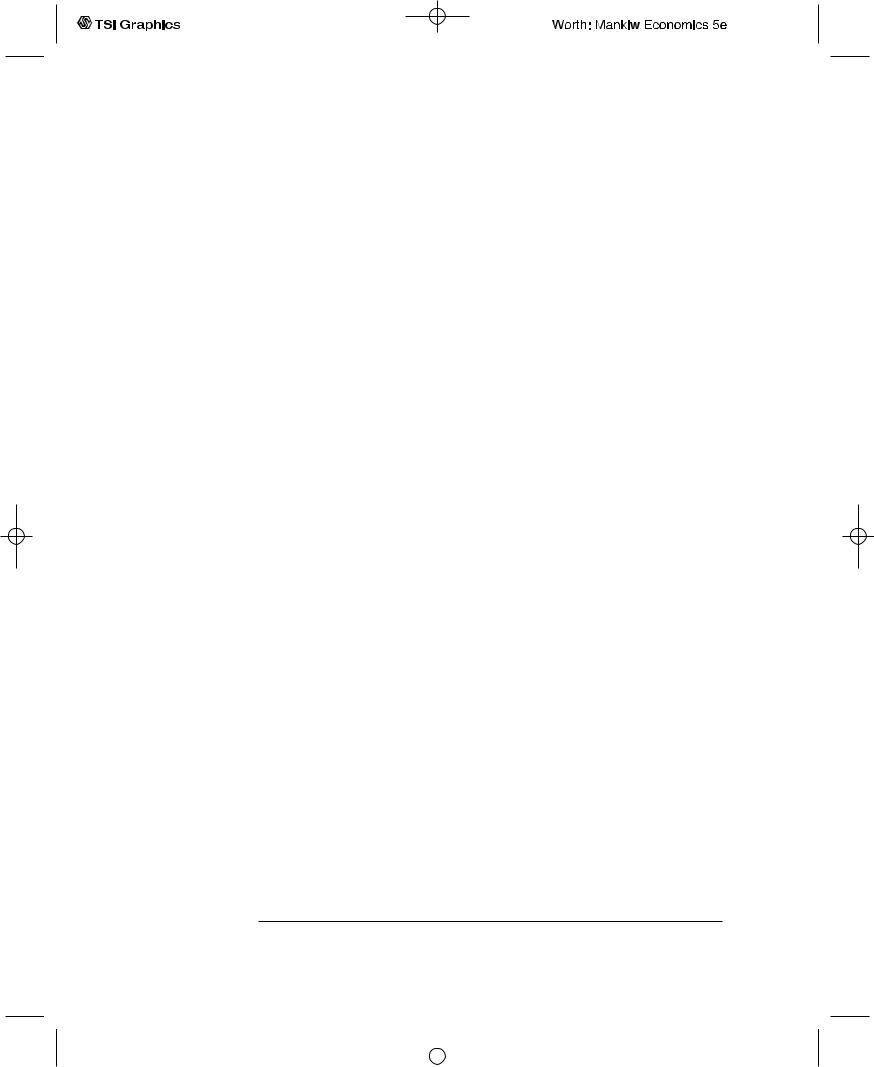
374 | P A R T I V Business Cycle Theory: The Economy in the Short Run
a.If this view is correct, how does a tax cut affect the natural rate of output?
b.How does a tax cut affect the aggregate demand curve? The long-run aggregate supply curve? The short-run aggregate supply curve?
c.What is the short-run impact of a tax cut on output and the price level? How does your answer differ from the case without the laborsupply effect?
d.What is the long-run impact of a tax cut on output and the price level? How does your answer differ from the case without the laborsupply effect?
8.Economist Alan Blinder, whom Bill Clinton appointed to be Vice Chairman of the Federal Reserve, once wrote the following:
The costs that attend the low and moderate inflation rates experienced in the United States and in other
industrial countries appear to be quite modest— more like a bad cold than a cancer on society. . . .
As rational individuals, we do not volunteer for a lobotomy to cure a head cold. Yet, as a collectivity, we routinely prescribe the economic equivalent of lobotomy (high unemployment) as a cure for the inflationary cold.15
What do you think Blinder meant by this? What are the policy implications of the viewpoint Blinder is advocating? Do you agree? Why or why not?
9.Go to the Web site of the Bureau of Labor Statistics (www.bls.gov). For each of the past five years, find the inflation rate as measured by the consumer price index (all items) and as measured by the CPI excluding food and energy. Compare these two measures of inflation. Why might they be different? What might the difference tell you about shifts in the aggregate supply curve and in the short-run Phillips curve?
15 Alan Blinder, Hard Heads, Soft Hearts:Tough-Minded Economics for a Just Society (Reading, Mass.: Addison-Wesley, 1987), 51.
User JOEWA:Job EFF01429:6264_ch13:Pg 374:27781#/eps at 100% *27781* |
Mon, Feb 18, 2002 12:57 AM |
|||
|
|
|
|
|
|
|
|
|
|
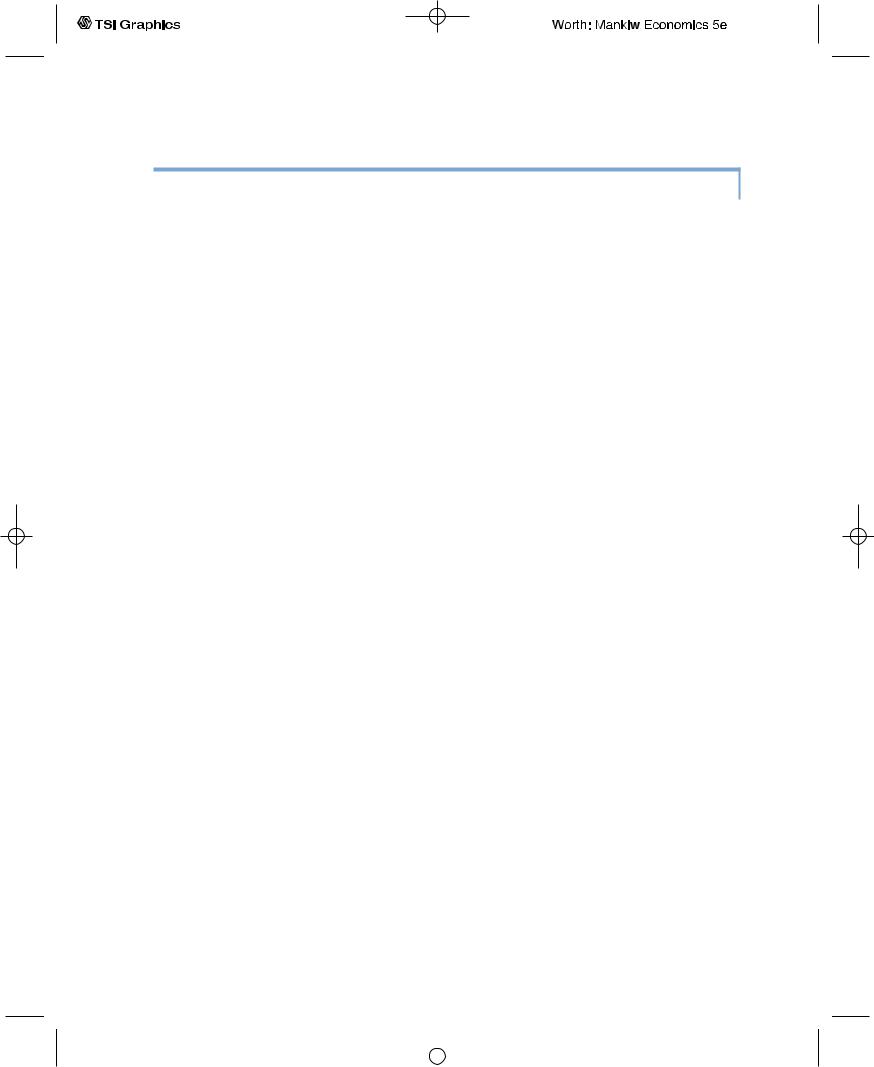
C H A P T E R 1 3 Aggregate Supply | 375
A P P E N D I X
A Big, Comprehensive Model
In the previous chapters, we have seen many models of how the economy works. When learning these models, it can be hard to see how they are related. Now that we have finished developing the model of aggregate demand and aggregate supply, this is a good time to look back at what we have learned.This appendix sketches a large model that incorporates much of the theory we have already seen, including the classical theory presented in Part II and the business cycle theory presented in Part IV. The notation and equations should be familiar from previous chapters.
The model has seven equations:
Y = C(Y −T ) + I(r) + G + NX(e) |
||
M/P = L(i,Y ) |
|
|
NX(e) = CF(r − r*) |
|
|
i = r + pe |
|
|
e = eP/P* |
|
|
− |
e |
) |
Y = Y |
+ a(P − P |
|
− |
− − |
|
Y = F(K , L ) |
|
|
IS: Goods Market Equilibrium
LM: Money Market Equilibrium
Foreign Exchange Market
Equilibrium
Relationship Between Real and
Nominal Interest Rates
Relationship Between Real and
Nominal Exchange Rates
Aggregate Supply
Natural Rate of Output
These seven equations determine the equilibrium values of seven endogenous
−
variables: output Y, the natural rate of output Y , the real interest rate r, the nominal interest rate i, the real exchange rate e, the nominal exchange rate e, and the price level P.
There are many exogenous variables that influence these endogenous variables. They include the money supply M, government purchases G, taxes T, the capital stock K, the labor force L, the world price level P *, and the world real interest rate r*. In addition, there are two expectational variables: the expectation of future inflation pe and the expectation of the current price level formed in the past P e. As written, the model takes these expectational variables as exogenous, although additional equations could be added to make them endogenous.
Although mathematical techniques are available to analyze this seven-equation model, they are beyond the scope of this book. But this large model is still useful, because we can use it to see how the smaller models we have examined are related to one another. In particular, many of the models we have been studying are special cases of this large model. Let’s consider six special cases.
Special Case 1: The Classical Closed Economy Suppose that P e = P, L(i, Y )
= (1/V )Y, and CF(r − r*) = 0. In words, this means that expectations of the price
User JOEWA:Job EFF01429:6264_ch13:Pg 375:27782#/eps at 100% *27782* |
Mon, Feb 18, 2002 12:57 AM |
|||
|
|
|
|
|
|
|
|
|
|
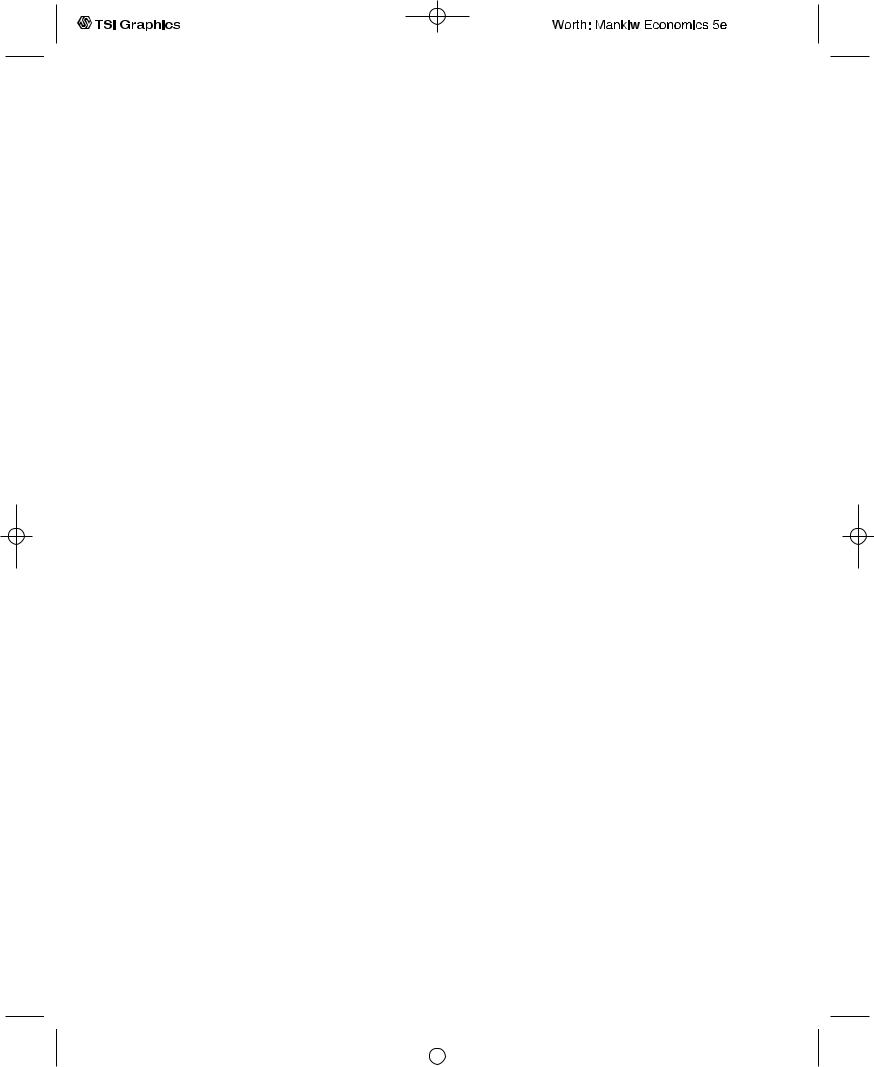
376 | P A R T I V Business Cycle Theory: The Economy in the Short Run
level adjust so that expectations are correct, that money demand is proportional to income, and that there are no international capital flows. In this case, output is always at its natural rate, the real interest rate adjusts to equilibrate the goods market, the price level moves parallel with the money supply, and the nominal interest rate adjusts one-for-one with expected inflation.This special case corresponds to the economy analyzed in Chapters 3 and 4.
Special Case 2: The Classical Small Open Economy Suppose that P e = P,
L(i, Y ) = (1/V )Y, and CF(r − r*) is infinitely elastic. Now we are examining the special case when international capital flows respond greatly to any differences between the domestic and world interest rates.This means that r = r* and that the trade balance NX equals the difference between saving and investment at the world interest rate. This special case corresponds to the economy analyzed in Chapter 5.
Special Case 3: The Basic Model of Aggregate Demand and Aggregate Supply Suppose that a is infinite and L(i, Y ) = (1/V )Y. In this case, the shortrun aggregate supply curve is horizontal, and the aggregate demand curve is determined only by the quantity equation. This special case corresponds to the economy analyzed in Chapter 9.
Special Case 4: The IS–LM Model Suppose that a is infinite and CF(r − r*) = 0. In this case, the short-run aggregate supply curve is horizontal, and there are no international capital flows. For any given level of expected inflation pe, the level of income and interest rate must adjust to equilibrate the goods market and the money market.This special case corresponds to the economy analyzed in Chapter 10 and 11.
Special Case 5: The Mundell–Fleming Model with a Floating Exchange Rate Suppose that a is infinite and CF(r − r*) is infinitely elastic. In this case, the short-run aggregate supply curve is horizontal, and international capital flows are so great as to ensure that r = r*.The exchange rate floats freely to reach its equilibrium level. This special case corresponds to the first economy analyzed in Chapter 12.
Special Case 6: The Mundell–Fleming Model with a Fixed Exchange Rate
Suppose that a is infinite, CF(r − r*) is infinitely elastic, and e is fixed. In this case, the short-run aggregate supply curve is horizontal, huge international capital flows ensure that r = r*, but the exchange rate is set by the central bank.The exchange rate is now an exogenous policy variable, but the money supply M is an endogenous variable that must adjust to ensure the exchange rate hits the fixed level. This special case corresponds to the second economy analyzed in Chapter 12.
You should now see the value in this big model. Even though the model is too large to be useful in developing an intuitive understanding of how the economy works, it shows that the different models we have been studying are closely related. Each model shows a different facet of the larger and more realistic model
User JOEWA:Job EFF01429:6264_ch13:Pg 376:27783#/eps at 100% *27783* |
Mon, Feb 18, 2002 12:57 AM |
|||
|
|
|
|
|
|
|
|
|
|
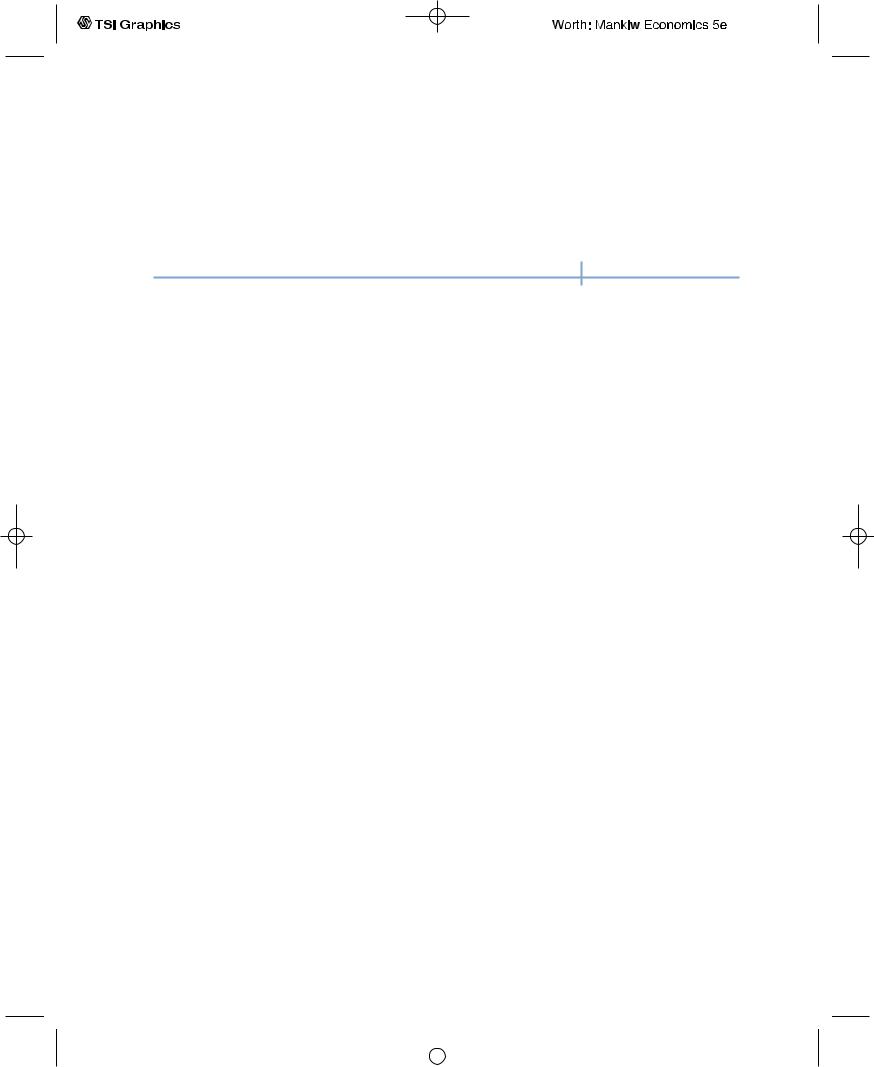
C H A P T E R 1 3 Aggregate Supply | 377
presented here. In each chapter, we made some simplifying assumptions to make the big model smaller and easier to understand. When thinking about the real world, it is important to keep the simplifying assumptions in mind and to draw on the insights learned in each of the chapters.
M O R E P R O B L E M S A N D A P P L I C A T I O N S
1.Let’s consider some more special cases of this large model. Starting with the large model, what extra assumptions would you need to yield each of the following models:
a.The model of the classical large open economy in the appendix to Chapter 5.
b.The Keynesian cross in the first half of Chapter 10.
c.The IS–LM model for the large open economy in the appendix to Chapter 12.
User JOEWA:Job EFF01429:6264_ch13:Pg 377:27784#/eps at 100% *27784* |
Mon, Feb 18, 2002 12:57 AM |
|||
|
|
|
|
|
|
|
|
|
|
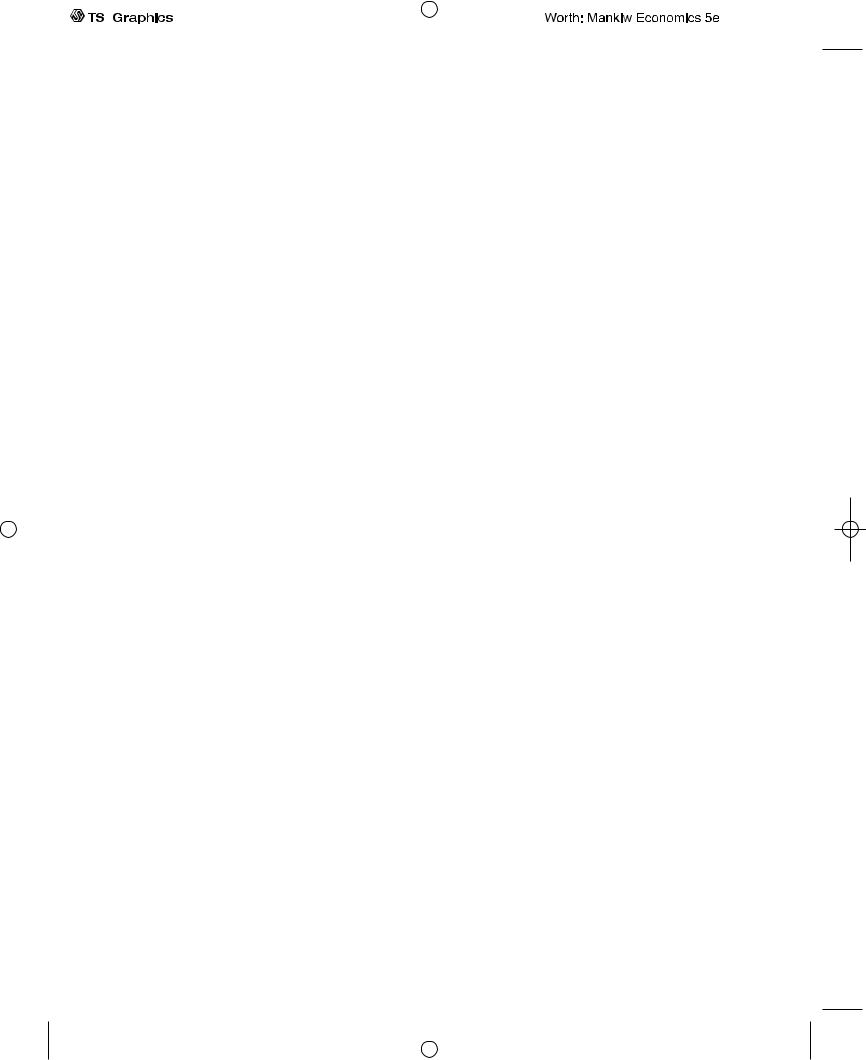
|
|
|
|
|
|
|
|
|
|
|
|
|
|
|
|
|
|
|
|
|
|
|
|
|
|
|
|
|
|
|
|
|
|
|
|
|
|
|
|
|
|
|
|
|
|
|
|
|
|
|
|
|
|
|
|
|
|
|
|
|
|
|
|
|
|
|
|
|
|
|
|
|
|
|
|
|
|
|
|
|
|
|
|
|
|
|
|
|
|
|
|
|
|
|
|
|
|
|
|
|
|
|
|
|
|
|
|
|
|
|
|
|
|
|
|
|
|
|
|
|
|
|
|
|
|
|
|
|
|
||
User JOEWA:Job EFF01430:6264_ch14:Pg 378:26544#/eps at 100% *26544* |
Mon, Feb 18, 2002 1:02 AM |
||||||||||
|
|
|
|
|
|
|
|
|
|
|
|
|
|
|
|
|
|
|
|
|
|
|
|
